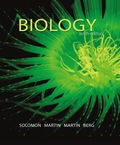
Concept explainers
Where is chlorophyll located in the chloroplast? (a) thylakoid membranes (b) stroma (c) matrix (d) thylakoid lumen (e) between the inner and outer membranes
Introduction: Photosynthesis is a process by which carbon dioxide and water are used to produce glucose molecules by using energy from sunlight. During this process, oxygen gas is evolved.
Answer to Problem 1TYU
Correct answer: The chlorophyll is located in the thylakoid membranes of the chloroplast. Hence, the correct answer is option (a).
Explanation of Solution
Reason for the correct answer:
Chloroplast is a double membrane bound organelle present in green plants and algae. The several reactions of the photosynthesis take place in the chloroplast of the plant cell that contains the green pigment chlorophyll. The chlorophyll is located within the thylakoid membrane of the chloroplast. The thylakoid membrane consists of two photosystem units: PSI and PSII. The thylakoid membrane separates the chloroplast into two compartments namely the chloroplast stroma and thylakoid lumen. These photosystem units absorb sunlight and pass it to an antenna molecule to drive the photosynthesis process.
Option (a) is given as “thylakoid membranes”.
The chlorophyll (green pigments) is found in the thylakoid membranes of the chloroplast.
Hence, the correct answer is option (a).
Reasons for incorrect answers:
Option (b) is given as, “stroma”.
The stroma is the fluid or aqueous layer which is enclosed by the inner membrane of the chloroplast. Chlorophyll is present in the thylakoid membrane, not in stroma.
Hence, option (b) is incorrect.
Option (c) is given as, “matrix”.
Matrix is a gel like substance present in the mitochondria, not in the chloroplast. Chlorophyll is present in the thylakoid membrane of chloroplast, not in the matrix.
Hence, option (c) is incorrect.
Option (d) is given as, “thylakoid lumen”.
The thylakoid membrane separates the chloroplast into two compartments: chloroplast stroma and thylakoid lumen (continuous aqueous phase). Chlorophyll is present in the thylakoid membrane, not in thylakoid lumen.
Hence, option (d) is incorrect.
Option (e) is given as, “between the inner and outer membranes”.
Chloroplast is a double membrane (inner and outer membrane) bound organelle present in green plants and algae. Chlorophyll is present in the thylakoid membrane, not in between the inner and outer membranes of the cell.
Hence, option (e) is incorrect.
Hence, the options (b), (c), (d), and (e) are incorrect.
Chlorophyll is located in the thylakoid membranes in the chloroplast.
Want to see more full solutions like this?
Chapter 9 Solutions
EBK BIOLOGY
- Briefly state the physical meaning of the electrocapillary equation (Lippman equation).arrow_forwardExplain in a small summary how: What genetic information can be obtained from a Punnet square? What genetic information cannot be determined from a Punnet square? Why might a Punnet Square be beneficial to understanding genetics/inheritance?arrow_forwardIn a small summary write down:arrow_forward
- Not part of a graded assignment, from a past midtermarrow_forwardNoggin mutation: The mouse, one of the phenotypic consequences of Noggin mutationis mispatterning of the spinal cord, in the posterior region of the mouse embryo, suchthat in the hindlimb region the more ventral fates are lost, and the dorsal Pax3 domain isexpanded. (this experiment is not in the lectures).a. Hypothesis for why: What would be your hypothesis for why the ventral fatesare lost and dorsal fates expanded? Include in your answer the words notochord,BMP, SHH and either (or both of) surface ectoderm or lateral plate mesodermarrow_forwardNot part of a graded assignment, from a past midtermarrow_forward
 Biology (MindTap Course List)BiologyISBN:9781337392938Author:Eldra Solomon, Charles Martin, Diana W. Martin, Linda R. BergPublisher:Cengage Learning
Biology (MindTap Course List)BiologyISBN:9781337392938Author:Eldra Solomon, Charles Martin, Diana W. Martin, Linda R. BergPublisher:Cengage Learning
 Biology: The Unity and Diversity of Life (MindTap...BiologyISBN:9781305073951Author:Cecie Starr, Ralph Taggart, Christine Evers, Lisa StarrPublisher:Cengage Learning
Biology: The Unity and Diversity of Life (MindTap...BiologyISBN:9781305073951Author:Cecie Starr, Ralph Taggart, Christine Evers, Lisa StarrPublisher:Cengage Learning Biology 2eBiologyISBN:9781947172517Author:Matthew Douglas, Jung Choi, Mary Ann ClarkPublisher:OpenStax
Biology 2eBiologyISBN:9781947172517Author:Matthew Douglas, Jung Choi, Mary Ann ClarkPublisher:OpenStax Concepts of BiologyBiologyISBN:9781938168116Author:Samantha Fowler, Rebecca Roush, James WisePublisher:OpenStax College
Concepts of BiologyBiologyISBN:9781938168116Author:Samantha Fowler, Rebecca Roush, James WisePublisher:OpenStax College Biology: The Dynamic Science (MindTap Course List)BiologyISBN:9781305389892Author:Peter J. Russell, Paul E. Hertz, Beverly McMillanPublisher:Cengage Learning
Biology: The Dynamic Science (MindTap Course List)BiologyISBN:9781305389892Author:Peter J. Russell, Paul E. Hertz, Beverly McMillanPublisher:Cengage Learning





